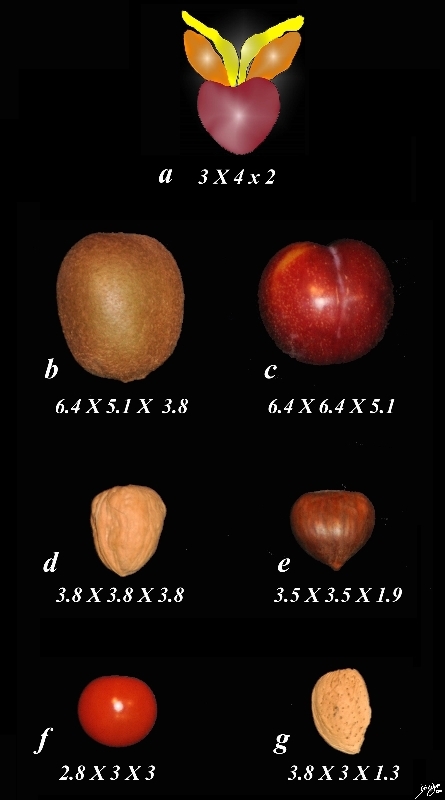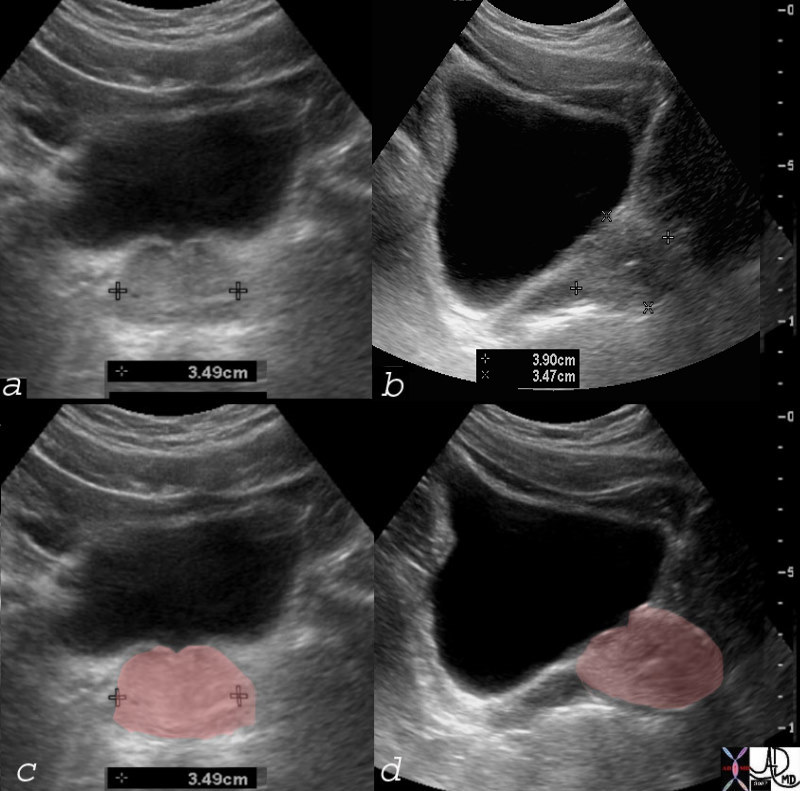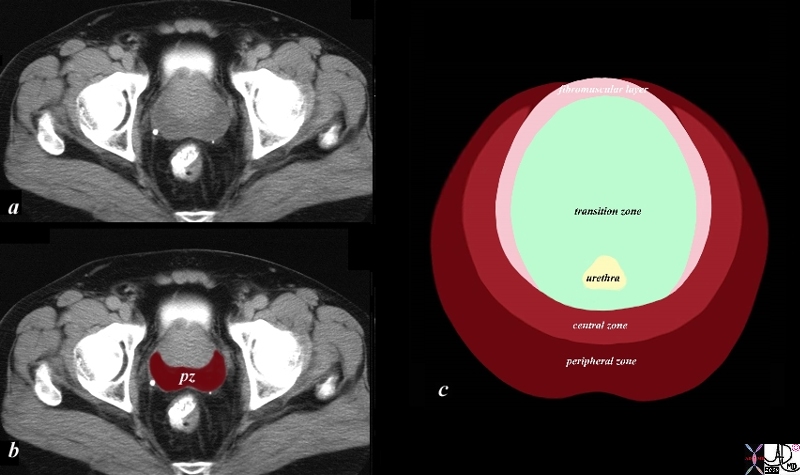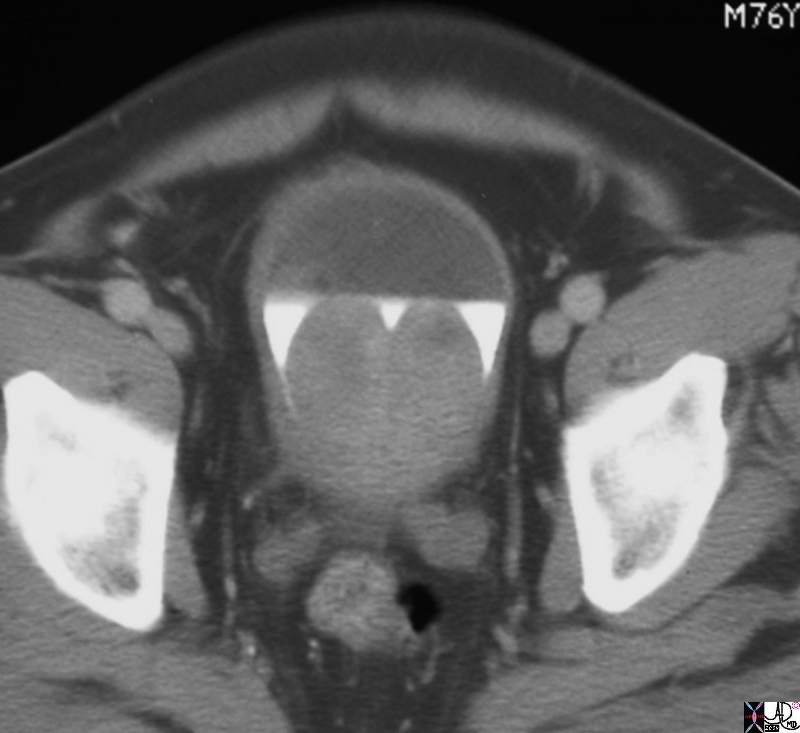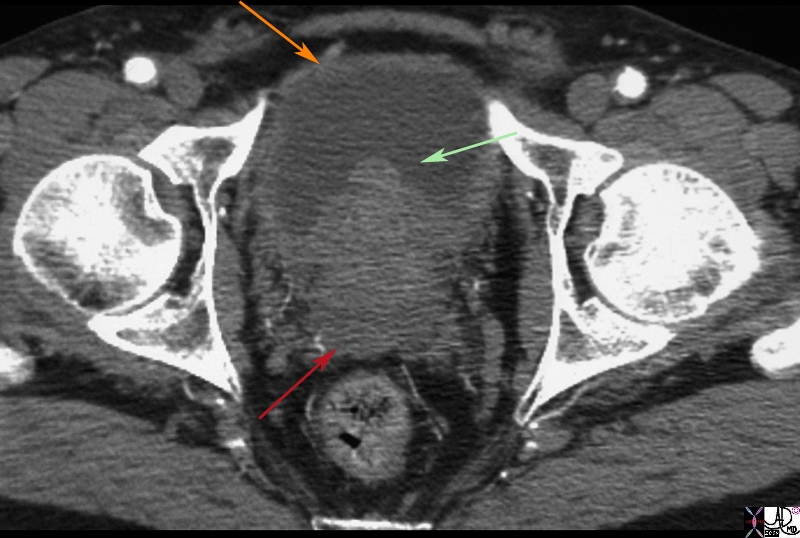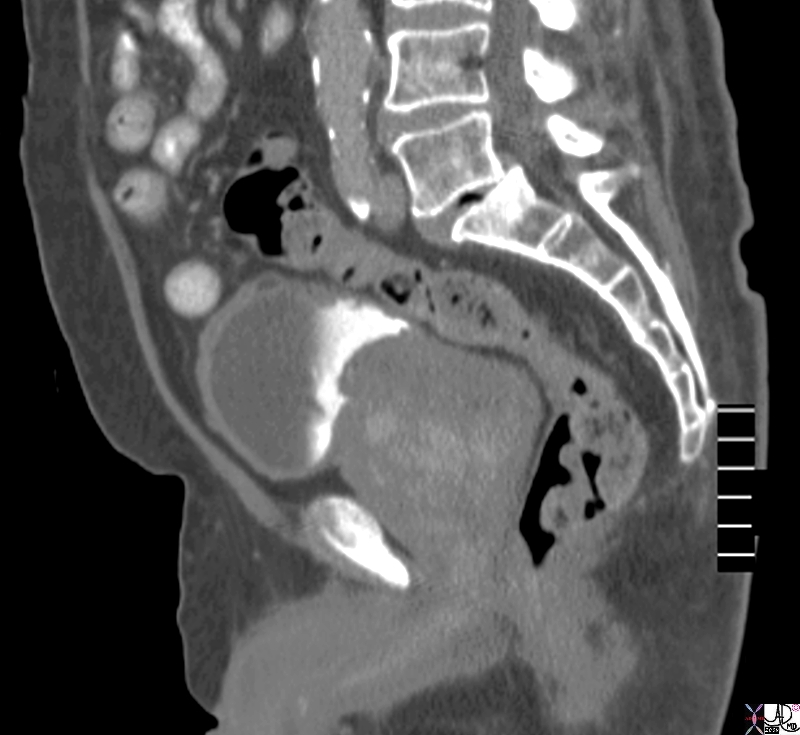Alok Anand MD Ashley Davidoff MD
The Common Vein Copyright 2010
Introduction
The size of prostate is smaller than one would imagine. It has been compared to a small kiwi fruit, small plum, an almond and a chestnut. In fact after a small experiment involving the purchase of these fine fruits and nuts it was found that the chestnut was closest in size in all dimensions.
|
Size of the Prostate |
|
The diagram depicts the variety of structures that have been compared to the size of the prostate. After a shopping spree to Russo?s in Newton Massachusetts and some significant research into the true sizes of the fruits and nuts that have been compared to the prostate, it was found that the chestnut (e) is closest to the size of the prostate. The kiwi (b) and plum (c) were far larger and A-P dimensions particularly excessively large. The walnut (d) was close but A-P dimension too large, the plum tomato (f) too round, and the almond (g) too thin in the A-P dimension. Courtesy Ashley Davidoff MD Copyright 2010 99662c04L.81s |
By virtue of its small size, it does not allow it to store large amounts of secretions. A normal prostate gland weighs about 20g-30g in a 30 year old male. The normal volume is between 20-30ccs. The prostate normally measures 3 cm in length (height), 4 cm in width (transverse), and 2 cm in depth (anteroposterior dimension).
It remains relatively stable in size until the age of 50 when increasing weight of the gland is observed. By the age of 80, the average prostatic weight is 35-45g.
Prostate Volume Calculation
A simple prorated ellipsoid formula is commonly used to calculate prostate volume: (anterior-posterior diameter) x (transverse diameter) x (superior-inferior diameter) x ?/6 (approximately 0.52) is accurate and reproducible.
From a practical point of view in imaging the gland is usually enlarged if the transverse dimension is greater than 4cms.
|
Normal Prostate by Ultrasound |
|
The volume of this gland is calculated by the formula using a simple prorated ellipsoid formula. Thus transverse diameter of 3.5cms is multiplied by A-P dimension of 3.5cms by the craniocaudad dimension of 3.9cms and then by a correction factor of .52 . This calculation reveals a volume of 25ccs which is normal. Courtesy Ashley Davidoff MD 74897c03 |
Applied Biology
DOMElement Object
(
[schemaTypeInfo] =>
[tagName] => table
[firstElementChild] => (object value omitted)
[lastElementChild] => (object value omitted)
[childElementCount] => 1
[previousElementSibling] => (object value omitted)
[nextElementSibling] =>
[nodeName] => table
[nodeValue] =>
Large Gland in the Sagittal Plane
The CTscan reconstructed in the sagittal plane is from a patient with an enlarged prostate. The anterior aspect of the gland protrudes with two symmetrical homogeneous components likely representing an enlarged transitional zone and prostate hyperplasia though by the nature of the disease the combination of cancer and BPH commonly coexist. The matrix of the gland is heterogeneous The bladder wall is thickened anteriorly.
Image Courtesy Ashley Davidoff MD Copyright 2010 76771.8s
[nodeType] => 1
[parentNode] => (object value omitted)
[childNodes] => (object value omitted)
[firstChild] => (object value omitted)
[lastChild] => (object value omitted)
[previousSibling] => (object value omitted)
[nextSibling] => (object value omitted)
[attributes] => (object value omitted)
[ownerDocument] => (object value omitted)
[namespaceURI] =>
[prefix] =>
[localName] => table
[baseURI] =>
[textContent] =>
Large Gland in the Sagittal Plane
The CTscan reconstructed in the sagittal plane is from a patient with an enlarged prostate. The anterior aspect of the gland protrudes with two symmetrical homogeneous components likely representing an enlarged transitional zone and prostate hyperplasia though by the nature of the disease the combination of cancer and BPH commonly coexist. The matrix of the gland is heterogeneous The bladder wall is thickened anteriorly.
Image Courtesy Ashley Davidoff MD Copyright 2010 76771.8s
)
DOMElement Object
(
[schemaTypeInfo] =>
[tagName] => td
[firstElementChild] => (object value omitted)
[lastElementChild] => (object value omitted)
[childElementCount] => 2
[previousElementSibling] =>
[nextElementSibling] =>
[nodeName] => td
[nodeValue] =>
The CTscan reconstructed in the sagittal plane is from a patient with an enlarged prostate. The anterior aspect of the gland protrudes with two symmetrical homogeneous components likely representing an enlarged transitional zone and prostate hyperplasia though by the nature of the disease the combination of cancer and BPH commonly coexist. The matrix of the gland is heterogeneous The bladder wall is thickened anteriorly.
Image Courtesy Ashley Davidoff MD Copyright 2010 76771.8s
[nodeType] => 1
[parentNode] => (object value omitted)
[childNodes] => (object value omitted)
[firstChild] => (object value omitted)
[lastChild] => (object value omitted)
[previousSibling] => (object value omitted)
[nextSibling] => (object value omitted)
[attributes] => (object value omitted)
[ownerDocument] => (object value omitted)
[namespaceURI] =>
[prefix] =>
[localName] => td
[baseURI] =>
[textContent] =>
The CTscan reconstructed in the sagittal plane is from a patient with an enlarged prostate. The anterior aspect of the gland protrudes with two symmetrical homogeneous components likely representing an enlarged transitional zone and prostate hyperplasia though by the nature of the disease the combination of cancer and BPH commonly coexist. The matrix of the gland is heterogeneous The bladder wall is thickened anteriorly.
Image Courtesy Ashley Davidoff MD Copyright 2010 76771.8s
)
DOMElement Object
(
[schemaTypeInfo] =>
[tagName] => td
[firstElementChild] => (object value omitted)
[lastElementChild] => (object value omitted)
[childElementCount] => 2
[previousElementSibling] =>
[nextElementSibling] =>
[nodeName] => td
[nodeValue] =>
Large Gland in the Sagittal Plane
[nodeType] => 1
[parentNode] => (object value omitted)
[childNodes] => (object value omitted)
[firstChild] => (object value omitted)
[lastChild] => (object value omitted)
[previousSibling] => (object value omitted)
[nextSibling] => (object value omitted)
[attributes] => (object value omitted)
[ownerDocument] => (object value omitted)
[namespaceURI] =>
[prefix] =>
[localName] => td
[baseURI] =>
[textContent] =>
Large Gland in the Sagittal Plane
)
DOMElement Object
(
[schemaTypeInfo] =>
[tagName] => table
[firstElementChild] => (object value omitted)
[lastElementChild] => (object value omitted)
[childElementCount] => 1
[previousElementSibling] => (object value omitted)
[nextElementSibling] => (object value omitted)
[nodeName] => table
[nodeValue] =>
Large Irregular Gland
The CTscan is from a patient with an enlarged prostate. The anterior aspect of the gland protrudes into the bladder with an irregular shape (green arrow). The bladder wall is slightly thickened (orange arrow). The peripheral zone is suggested by a hypodense posterior region (maroon arrow)
Image Courtesy Ashley Davidoff MD Copyright 2010 24842.81s
[nodeType] => 1
[parentNode] => (object value omitted)
[childNodes] => (object value omitted)
[firstChild] => (object value omitted)
[lastChild] => (object value omitted)
[previousSibling] => (object value omitted)
[nextSibling] => (object value omitted)
[attributes] => (object value omitted)
[ownerDocument] => (object value omitted)
[namespaceURI] =>
[prefix] =>
[localName] => table
[baseURI] =>
[textContent] =>
Large Irregular Gland
The CTscan is from a patient with an enlarged prostate. The anterior aspect of the gland protrudes into the bladder with an irregular shape (green arrow). The bladder wall is slightly thickened (orange arrow). The peripheral zone is suggested by a hypodense posterior region (maroon arrow)
Image Courtesy Ashley Davidoff MD Copyright 2010 24842.81s
)
DOMElement Object
(
[schemaTypeInfo] =>
[tagName] => td
[firstElementChild] => (object value omitted)
[lastElementChild] => (object value omitted)
[childElementCount] => 2
[previousElementSibling] =>
[nextElementSibling] =>
[nodeName] => td
[nodeValue] =>
The CTscan is from a patient with an enlarged prostate. The anterior aspect of the gland protrudes into the bladder with an irregular shape (green arrow). The bladder wall is slightly thickened (orange arrow). The peripheral zone is suggested by a hypodense posterior region (maroon arrow)
Image Courtesy Ashley Davidoff MD Copyright 2010 24842.81s
[nodeType] => 1
[parentNode] => (object value omitted)
[childNodes] => (object value omitted)
[firstChild] => (object value omitted)
[lastChild] => (object value omitted)
[previousSibling] => (object value omitted)
[nextSibling] => (object value omitted)
[attributes] => (object value omitted)
[ownerDocument] => (object value omitted)
[namespaceURI] =>
[prefix] =>
[localName] => td
[baseURI] =>
[textContent] =>
The CTscan is from a patient with an enlarged prostate. The anterior aspect of the gland protrudes into the bladder with an irregular shape (green arrow). The bladder wall is slightly thickened (orange arrow). The peripheral zone is suggested by a hypodense posterior region (maroon arrow)
Image Courtesy Ashley Davidoff MD Copyright 2010 24842.81s
)
DOMElement Object
(
[schemaTypeInfo] =>
[tagName] => td
[firstElementChild] => (object value omitted)
[lastElementChild] => (object value omitted)
[childElementCount] => 2
[previousElementSibling] =>
[nextElementSibling] =>
[nodeName] => td
[nodeValue] =>
Large Irregular Gland
[nodeType] => 1
[parentNode] => (object value omitted)
[childNodes] => (object value omitted)
[firstChild] => (object value omitted)
[lastChild] => (object value omitted)
[previousSibling] => (object value omitted)
[nextSibling] => (object value omitted)
[attributes] => (object value omitted)
[ownerDocument] => (object value omitted)
[namespaceURI] =>
[prefix] =>
[localName] => td
[baseURI] =>
[textContent] =>
Large Irregular Gland
)
DOMElement Object
(
[schemaTypeInfo] =>
[tagName] => table
[firstElementChild] => (object value omitted)
[lastElementChild] => (object value omitted)
[childElementCount] => 1
[previousElementSibling] => (object value omitted)
[nextElementSibling] => (object value omitted)
[nodeName] => table
[nodeValue] =>
Large Bilobed Smooth Gland
The CTscan is from a patient with an enlarged prostate. The anterior aspect of the gland protrudes with two symmetrical homogeneous components likely representing an enlarged transitional zone and prostate hyperplasia though by the nature of the disease the combination of cancer and BPH commonly coexist. The urinary bladder wall is minimally thickened.
Image Courtesy Ashley Davidoff MD Copyright 2010 25517b.8s
[nodeType] => 1
[parentNode] => (object value omitted)
[childNodes] => (object value omitted)
[firstChild] => (object value omitted)
[lastChild] => (object value omitted)
[previousSibling] => (object value omitted)
[nextSibling] => (object value omitted)
[attributes] => (object value omitted)
[ownerDocument] => (object value omitted)
[namespaceURI] =>
[prefix] =>
[localName] => table
[baseURI] =>
[textContent] =>
Large Bilobed Smooth Gland
The CTscan is from a patient with an enlarged prostate. The anterior aspect of the gland protrudes with two symmetrical homogeneous components likely representing an enlarged transitional zone and prostate hyperplasia though by the nature of the disease the combination of cancer and BPH commonly coexist. The urinary bladder wall is minimally thickened.
Image Courtesy Ashley Davidoff MD Copyright 2010 25517b.8s
)
DOMElement Object
(
[schemaTypeInfo] =>
[tagName] => td
[firstElementChild] => (object value omitted)
[lastElementChild] => (object value omitted)
[childElementCount] => 2
[previousElementSibling] =>
[nextElementSibling] =>
[nodeName] => td
[nodeValue] =>
The CTscan is from a patient with an enlarged prostate. The anterior aspect of the gland protrudes with two symmetrical homogeneous components likely representing an enlarged transitional zone and prostate hyperplasia though by the nature of the disease the combination of cancer and BPH commonly coexist. The urinary bladder wall is minimally thickened.
Image Courtesy Ashley Davidoff MD Copyright 2010 25517b.8s
[nodeType] => 1
[parentNode] => (object value omitted)
[childNodes] => (object value omitted)
[firstChild] => (object value omitted)
[lastChild] => (object value omitted)
[previousSibling] => (object value omitted)
[nextSibling] => (object value omitted)
[attributes] => (object value omitted)
[ownerDocument] => (object value omitted)
[namespaceURI] =>
[prefix] =>
[localName] => td
[baseURI] =>
[textContent] =>
The CTscan is from a patient with an enlarged prostate. The anterior aspect of the gland protrudes with two symmetrical homogeneous components likely representing an enlarged transitional zone and prostate hyperplasia though by the nature of the disease the combination of cancer and BPH commonly coexist. The urinary bladder wall is minimally thickened.
Image Courtesy Ashley Davidoff MD Copyright 2010 25517b.8s
)
DOMElement Object
(
[schemaTypeInfo] =>
[tagName] => td
[firstElementChild] => (object value omitted)
[lastElementChild] => (object value omitted)
[childElementCount] => 2
[previousElementSibling] =>
[nextElementSibling] =>
[nodeName] => td
[nodeValue] =>
Large Bilobed Smooth Gland
[nodeType] => 1
[parentNode] => (object value omitted)
[childNodes] => (object value omitted)
[firstChild] => (object value omitted)
[lastChild] => (object value omitted)
[previousSibling] => (object value omitted)
[nextSibling] => (object value omitted)
[attributes] => (object value omitted)
[ownerDocument] => (object value omitted)
[namespaceURI] =>
[prefix] =>
[localName] => td
[baseURI] =>
[textContent] =>
Large Bilobed Smooth Gland
)
DOMElement Object
(
[schemaTypeInfo] =>
[tagName] => table
[firstElementChild] => (object value omitted)
[lastElementChild] => (object value omitted)
[childElementCount] => 1
[previousElementSibling] => (object value omitted)
[nextElementSibling] => (object value omitted)
[nodeName] => table
[nodeValue] =>
BPH and Zonal Anatomy
The 70 year old male shows an enlarged prostate 7.2cms in A-P by 6.1cms. in the axial plane. The gland is enlarged based on these measurements. Two distinct zones are identified. . The posterior zone is canoe shaped is hypodense and represents the peripheral zone. The anterior more hyperdense layer is combination of zones. Since the prostate gland has 4 major zones and we have accounted for the peripheral zone (pz), three other zones are present. Inward of the peripheral zone is the central zone followed by the transitional zone and finally the anterior fibromuscular layer In this patient who has benign prostatic hypertrophy (BPH) the transitional zone is enlarged due to hyperplasia. Note that BPH is a misnomer because the enlargement is due to hyperplasia and not hypertrophy.
Image (c) illustrates the enlarged transitional zone which is where the hyperplasia of BPH takes place.
Image Courtesy Ashley Davidoff MD Copyright 2010 25078c04bL01.8s
[nodeType] => 1
[parentNode] => (object value omitted)
[childNodes] => (object value omitted)
[firstChild] => (object value omitted)
[lastChild] => (object value omitted)
[previousSibling] => (object value omitted)
[nextSibling] => (object value omitted)
[attributes] => (object value omitted)
[ownerDocument] => (object value omitted)
[namespaceURI] =>
[prefix] =>
[localName] => table
[baseURI] =>
[textContent] =>
BPH and Zonal Anatomy
The 70 year old male shows an enlarged prostate 7.2cms in A-P by 6.1cms. in the axial plane. The gland is enlarged based on these measurements. Two distinct zones are identified. . The posterior zone is canoe shaped is hypodense and represents the peripheral zone. The anterior more hyperdense layer is combination of zones. Since the prostate gland has 4 major zones and we have accounted for the peripheral zone (pz), three other zones are present. Inward of the peripheral zone is the central zone followed by the transitional zone and finally the anterior fibromuscular layer In this patient who has benign prostatic hypertrophy (BPH) the transitional zone is enlarged due to hyperplasia. Note that BPH is a misnomer because the enlargement is due to hyperplasia and not hypertrophy.
Image (c) illustrates the enlarged transitional zone which is where the hyperplasia of BPH takes place.
Image Courtesy Ashley Davidoff MD Copyright 2010 25078c04bL01.8s
)
DOMElement Object
(
[schemaTypeInfo] =>
[tagName] => td
[firstElementChild] => (object value omitted)
[lastElementChild] => (object value omitted)
[childElementCount] => 3
[previousElementSibling] =>
[nextElementSibling] =>
[nodeName] => td
[nodeValue] =>
The 70 year old male shows an enlarged prostate 7.2cms in A-P by 6.1cms. in the axial plane. The gland is enlarged based on these measurements. Two distinct zones are identified. . The posterior zone is canoe shaped is hypodense and represents the peripheral zone. The anterior more hyperdense layer is combination of zones. Since the prostate gland has 4 major zones and we have accounted for the peripheral zone (pz), three other zones are present. Inward of the peripheral zone is the central zone followed by the transitional zone and finally the anterior fibromuscular layer In this patient who has benign prostatic hypertrophy (BPH) the transitional zone is enlarged due to hyperplasia. Note that BPH is a misnomer because the enlargement is due to hyperplasia and not hypertrophy.
Image (c) illustrates the enlarged transitional zone which is where the hyperplasia of BPH takes place.
Image Courtesy Ashley Davidoff MD Copyright 2010 25078c04bL01.8s
[nodeType] => 1
[parentNode] => (object value omitted)
[childNodes] => (object value omitted)
[firstChild] => (object value omitted)
[lastChild] => (object value omitted)
[previousSibling] => (object value omitted)
[nextSibling] => (object value omitted)
[attributes] => (object value omitted)
[ownerDocument] => (object value omitted)
[namespaceURI] =>
[prefix] =>
[localName] => td
[baseURI] =>
[textContent] =>
The 70 year old male shows an enlarged prostate 7.2cms in A-P by 6.1cms. in the axial plane. The gland is enlarged based on these measurements. Two distinct zones are identified. . The posterior zone is canoe shaped is hypodense and represents the peripheral zone. The anterior more hyperdense layer is combination of zones. Since the prostate gland has 4 major zones and we have accounted for the peripheral zone (pz), three other zones are present. Inward of the peripheral zone is the central zone followed by the transitional zone and finally the anterior fibromuscular layer In this patient who has benign prostatic hypertrophy (BPH) the transitional zone is enlarged due to hyperplasia. Note that BPH is a misnomer because the enlargement is due to hyperplasia and not hypertrophy.
Image (c) illustrates the enlarged transitional zone which is where the hyperplasia of BPH takes place.
Image Courtesy Ashley Davidoff MD Copyright 2010 25078c04bL01.8s
)
DOMElement Object
(
[schemaTypeInfo] =>
[tagName] => td
[firstElementChild] => (object value omitted)
[lastElementChild] => (object value omitted)
[childElementCount] => 2
[previousElementSibling] =>
[nextElementSibling] =>
[nodeName] => td
[nodeValue] =>
BPH and Zonal Anatomy
[nodeType] => 1
[parentNode] => (object value omitted)
[childNodes] => (object value omitted)
[firstChild] => (object value omitted)
[lastChild] => (object value omitted)
[previousSibling] => (object value omitted)
[nextSibling] => (object value omitted)
[attributes] => (object value omitted)
[ownerDocument] => (object value omitted)
[namespaceURI] =>
[prefix] =>
[localName] => td
[baseURI] =>
[textContent] =>
BPH and Zonal Anatomy
)
DOMElement Object
(
[schemaTypeInfo] =>
[tagName] => table
[firstElementChild] => (object value omitted)
[lastElementChild] => (object value omitted)
[childElementCount] => 1
[previousElementSibling] => (object value omitted)
[nextElementSibling] => (object value omitted)
[nodeName] => table
[nodeValue] =>
BPH
The 70 year old male shows an enlarged prostate 7.2cms in A-P by 6.1cms. in the axial plane. The gland is enlarged based on these measurements. Two distinct zones are identified because the gland is abnormal. The posterior zone is canoe shaped is hypodense and represents the peripheral zone. The anterior region is more hyperdense layer and is combination of zones including the central zone, transition zone and the anterior fibromuscular layer. In this patient who has benign prostatic hyperplasia (BPH) the transitional zone is enlarged due to the hyperplasia
Image Courtesy Ashley Davidoff MD Copyright 2010 25078c04L.8s
[nodeType] => 1
[parentNode] => (object value omitted)
[childNodes] => (object value omitted)
[firstChild] => (object value omitted)
[lastChild] => (object value omitted)
[previousSibling] => (object value omitted)
[nextSibling] => (object value omitted)
[attributes] => (object value omitted)
[ownerDocument] => (object value omitted)
[namespaceURI] =>
[prefix] =>
[localName] => table
[baseURI] =>
[textContent] =>
BPH
The 70 year old male shows an enlarged prostate 7.2cms in A-P by 6.1cms. in the axial plane. The gland is enlarged based on these measurements. Two distinct zones are identified because the gland is abnormal. The posterior zone is canoe shaped is hypodense and represents the peripheral zone. The anterior region is more hyperdense layer and is combination of zones including the central zone, transition zone and the anterior fibromuscular layer. In this patient who has benign prostatic hyperplasia (BPH) the transitional zone is enlarged due to the hyperplasia
Image Courtesy Ashley Davidoff MD Copyright 2010 25078c04L.8s
)
DOMElement Object
(
[schemaTypeInfo] =>
[tagName] => td
[firstElementChild] => (object value omitted)
[lastElementChild] => (object value omitted)
[childElementCount] => 2
[previousElementSibling] =>
[nextElementSibling] =>
[nodeName] => td
[nodeValue] =>
The 70 year old male shows an enlarged prostate 7.2cms in A-P by 6.1cms. in the axial plane. The gland is enlarged based on these measurements. Two distinct zones are identified because the gland is abnormal. The posterior zone is canoe shaped is hypodense and represents the peripheral zone. The anterior region is more hyperdense layer and is combination of zones including the central zone, transition zone and the anterior fibromuscular layer. In this patient who has benign prostatic hyperplasia (BPH) the transitional zone is enlarged due to the hyperplasia
Image Courtesy Ashley Davidoff MD Copyright 2010 25078c04L.8s
[nodeType] => 1
[parentNode] => (object value omitted)
[childNodes] => (object value omitted)
[firstChild] => (object value omitted)
[lastChild] => (object value omitted)
[previousSibling] => (object value omitted)
[nextSibling] => (object value omitted)
[attributes] => (object value omitted)
[ownerDocument] => (object value omitted)
[namespaceURI] =>
[prefix] =>
[localName] => td
[baseURI] =>
[textContent] =>
The 70 year old male shows an enlarged prostate 7.2cms in A-P by 6.1cms. in the axial plane. The gland is enlarged based on these measurements. Two distinct zones are identified because the gland is abnormal. The posterior zone is canoe shaped is hypodense and represents the peripheral zone. The anterior region is more hyperdense layer and is combination of zones including the central zone, transition zone and the anterior fibromuscular layer. In this patient who has benign prostatic hyperplasia (BPH) the transitional zone is enlarged due to the hyperplasia
Image Courtesy Ashley Davidoff MD Copyright 2010 25078c04L.8s
)
DOMElement Object
(
[schemaTypeInfo] =>
[tagName] => td
[firstElementChild] => (object value omitted)
[lastElementChild] => (object value omitted)
[childElementCount] => 2
[previousElementSibling] =>
[nextElementSibling] =>
[nodeName] => td
[nodeValue] =>
BPH
[nodeType] => 1
[parentNode] => (object value omitted)
[childNodes] => (object value omitted)
[firstChild] => (object value omitted)
[lastChild] => (object value omitted)
[previousSibling] => (object value omitted)
[nextSibling] => (object value omitted)
[attributes] => (object value omitted)
[ownerDocument] => (object value omitted)
[namespaceURI] =>
[prefix] =>
[localName] => td
[baseURI] =>
[textContent] =>
BPH
)
DOMElement Object
(
[schemaTypeInfo] =>
[tagName] => table
[firstElementChild] => (object value omitted)
[lastElementChild] => (object value omitted)
[childElementCount] => 1
[previousElementSibling] => (object value omitted)
[nextElementSibling] => (object value omitted)
[nodeName] => table
[nodeValue] =>
Normal Prostate by Ultrasound
The volume of this gland is calculated by the formula using a simple prorated ellipsoid formula. Thus transverse diameter of 3.5cms is multiplied by A-P dimension of 3.5cms by the craniocaudad dimension of 3.9cms and then by a correction factor of .52 . This calculation reveals a volume of 25ccs which is normal.
Courtesy Ashley Davidoff MD 74897c03
[nodeType] => 1
[parentNode] => (object value omitted)
[childNodes] => (object value omitted)
[firstChild] => (object value omitted)
[lastChild] => (object value omitted)
[previousSibling] => (object value omitted)
[nextSibling] => (object value omitted)
[attributes] => (object value omitted)
[ownerDocument] => (object value omitted)
[namespaceURI] =>
[prefix] =>
[localName] => table
[baseURI] =>
[textContent] =>
Normal Prostate by Ultrasound
The volume of this gland is calculated by the formula using a simple prorated ellipsoid formula. Thus transverse diameter of 3.5cms is multiplied by A-P dimension of 3.5cms by the craniocaudad dimension of 3.9cms and then by a correction factor of .52 . This calculation reveals a volume of 25ccs which is normal.
Courtesy Ashley Davidoff MD 74897c03
)
DOMElement Object
(
[schemaTypeInfo] =>
[tagName] => td
[firstElementChild] => (object value omitted)
[lastElementChild] => (object value omitted)
[childElementCount] => 2
[previousElementSibling] =>
[nextElementSibling] =>
[nodeName] => td
[nodeValue] =>
The volume of this gland is calculated by the formula using a simple prorated ellipsoid formula. Thus transverse diameter of 3.5cms is multiplied by A-P dimension of 3.5cms by the craniocaudad dimension of 3.9cms and then by a correction factor of .52 . This calculation reveals a volume of 25ccs which is normal.
Courtesy Ashley Davidoff MD 74897c03
[nodeType] => 1
[parentNode] => (object value omitted)
[childNodes] => (object value omitted)
[firstChild] => (object value omitted)
[lastChild] => (object value omitted)
[previousSibling] => (object value omitted)
[nextSibling] => (object value omitted)
[attributes] => (object value omitted)
[ownerDocument] => (object value omitted)
[namespaceURI] =>
[prefix] =>
[localName] => td
[baseURI] =>
[textContent] =>
The volume of this gland is calculated by the formula using a simple prorated ellipsoid formula. Thus transverse diameter of 3.5cms is multiplied by A-P dimension of 3.5cms by the craniocaudad dimension of 3.9cms and then by a correction factor of .52 . This calculation reveals a volume of 25ccs which is normal.
Courtesy Ashley Davidoff MD 74897c03
)
DOMElement Object
(
[schemaTypeInfo] =>
[tagName] => td
[firstElementChild] => (object value omitted)
[lastElementChild] => (object value omitted)
[childElementCount] => 2
[previousElementSibling] =>
[nextElementSibling] =>
[nodeName] => td
[nodeValue] =>
Normal Prostate by Ultrasound
[nodeType] => 1
[parentNode] => (object value omitted)
[childNodes] => (object value omitted)
[firstChild] => (object value omitted)
[lastChild] => (object value omitted)
[previousSibling] => (object value omitted)
[nextSibling] => (object value omitted)
[attributes] => (object value omitted)
[ownerDocument] => (object value omitted)
[namespaceURI] =>
[prefix] =>
[localName] => td
[baseURI] =>
[textContent] =>
Normal Prostate by Ultrasound
)
DOMElement Object
(
[schemaTypeInfo] =>
[tagName] => table
[firstElementChild] => (object value omitted)
[lastElementChild] => (object value omitted)
[childElementCount] => 1
[previousElementSibling] => (object value omitted)
[nextElementSibling] => (object value omitted)
[nodeName] => table
[nodeValue] =>
Size of the Prostate
The diagram depicts the variety of structures that have been compared to the size of the prostate. After a shopping spree to Russo?s in Newton Massachusetts and some significant research into the true sizes of the fruits and nuts that have been compared to the prostate, it was found that the chestnut (e) is closest to the size of the prostate. The kiwi (b) and plum (c) were far larger and A-P dimensions particularly excessively large. The walnut (d) was close but A-P dimension too large, the plum tomato (f) too round, and the almond (g) too thin in the A-P dimension.
Courtesy Ashley Davidoff MD Copyright 2010 99662c04L.81s
[nodeType] => 1
[parentNode] => (object value omitted)
[childNodes] => (object value omitted)
[firstChild] => (object value omitted)
[lastChild] => (object value omitted)
[previousSibling] => (object value omitted)
[nextSibling] => (object value omitted)
[attributes] => (object value omitted)
[ownerDocument] => (object value omitted)
[namespaceURI] =>
[prefix] =>
[localName] => table
[baseURI] =>
[textContent] =>
Size of the Prostate
The diagram depicts the variety of structures that have been compared to the size of the prostate. After a shopping spree to Russo?s in Newton Massachusetts and some significant research into the true sizes of the fruits and nuts that have been compared to the prostate, it was found that the chestnut (e) is closest to the size of the prostate. The kiwi (b) and plum (c) were far larger and A-P dimensions particularly excessively large. The walnut (d) was close but A-P dimension too large, the plum tomato (f) too round, and the almond (g) too thin in the A-P dimension.
Courtesy Ashley Davidoff MD Copyright 2010 99662c04L.81s
)
DOMElement Object
(
[schemaTypeInfo] =>
[tagName] => td
[firstElementChild] => (object value omitted)
[lastElementChild] => (object value omitted)
[childElementCount] => 2
[previousElementSibling] =>
[nextElementSibling] =>
[nodeName] => td
[nodeValue] =>
The diagram depicts the variety of structures that have been compared to the size of the prostate. After a shopping spree to Russo?s in Newton Massachusetts and some significant research into the true sizes of the fruits and nuts that have been compared to the prostate, it was found that the chestnut (e) is closest to the size of the prostate. The kiwi (b) and plum (c) were far larger and A-P dimensions particularly excessively large. The walnut (d) was close but A-P dimension too large, the plum tomato (f) too round, and the almond (g) too thin in the A-P dimension.
Courtesy Ashley Davidoff MD Copyright 2010 99662c04L.81s
[nodeType] => 1
[parentNode] => (object value omitted)
[childNodes] => (object value omitted)
[firstChild] => (object value omitted)
[lastChild] => (object value omitted)
[previousSibling] => (object value omitted)
[nextSibling] => (object value omitted)
[attributes] => (object value omitted)
[ownerDocument] => (object value omitted)
[namespaceURI] =>
[prefix] =>
[localName] => td
[baseURI] =>
[textContent] =>
The diagram depicts the variety of structures that have been compared to the size of the prostate. After a shopping spree to Russo?s in Newton Massachusetts and some significant research into the true sizes of the fruits and nuts that have been compared to the prostate, it was found that the chestnut (e) is closest to the size of the prostate. The kiwi (b) and plum (c) were far larger and A-P dimensions particularly excessively large. The walnut (d) was close but A-P dimension too large, the plum tomato (f) too round, and the almond (g) too thin in the A-P dimension.
Courtesy Ashley Davidoff MD Copyright 2010 99662c04L.81s
)
DOMElement Object
(
[schemaTypeInfo] =>
[tagName] => td
[firstElementChild] => (object value omitted)
[lastElementChild] => (object value omitted)
[childElementCount] => 2
[previousElementSibling] =>
[nextElementSibling] =>
[nodeName] => td
[nodeValue] =>
Size of the Prostate
[nodeType] => 1
[parentNode] => (object value omitted)
[childNodes] => (object value omitted)
[firstChild] => (object value omitted)
[lastChild] => (object value omitted)
[previousSibling] => (object value omitted)
[nextSibling] => (object value omitted)
[attributes] => (object value omitted)
[ownerDocument] => (object value omitted)
[namespaceURI] =>
[prefix] =>
[localName] => td
[baseURI] =>
[textContent] =>
Size of the Prostate
)

